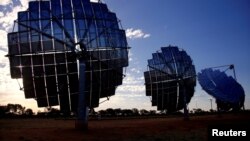Australia is installing renewable energy facilities at a faster rate than any other country. Research shows Australia is on track to meet its Paris climate commitments five years earlier than expected — in 2025.
Australia is enjoying a green energy revolution. It is installing renewable energy facilities faster than anywhere else, and research shows Australia is on track to meet its Paris climate commitments five years early. The agreement reached in the French capital in 2016 stressed the need for global action to cut greenhouse gas emissions.
Academics say at the current rate Australia can expect to be 100 percent powered by green sources within a decade-and-a-half.
Andrew Blakers is a professor of engineering at the Australian National University.
“Currently above 20 percent renewable electricity. At this rate we are going to get to 50 percent in 2024, and 100 percent in about 2032 if we just keep doing exactly what we are doing now. This is four or five faster per capita than the United States, China, Japan or the European Union,” he said.
The research from the Australian National University contrasts previous studies, which found Australia is not on track to meet its obligations under the Paris Agreement. The 2018 Emissions Gap Report from the United Nations listed Australia as a G20 country that will not meet its 2030 emission reduction target.
There is broad agreement, however, that renewable energy has an increasingly important part to play in Australia.
It is a sunny and windy place. It has a range of renewable power sources, including solar, wind, hydro and geothermal energy, which taps heat in the earth. It has a growing rooftop solar industry. At the end of last year, more than 2 million Australian homes had rooftop solar systems.
Renewable energy will help to cut emissions in Australia, which still uses coal to generate much of its electricity.
Recent extreme conditions in Australia have again focused attention on the impact of climate change.
January was the hottest month ever documented, and 2018 was the third warmest year on record.
The Bureau of Meteorology says that while it cannot attribute individual heatwaves to climate change, it states that as the planet warms, bursts of extreme heat will become more frequent and intense.





